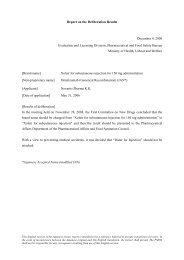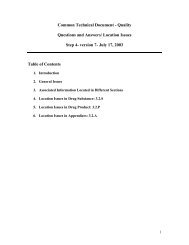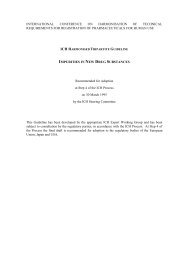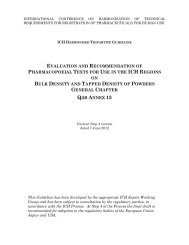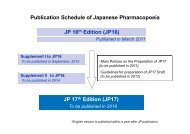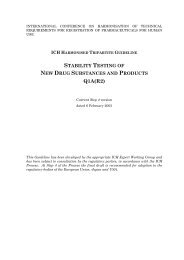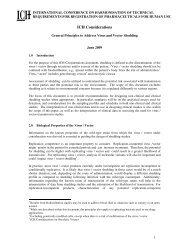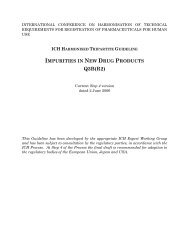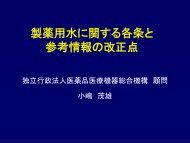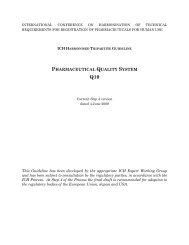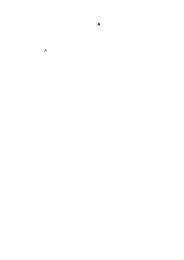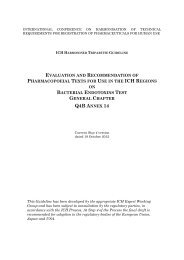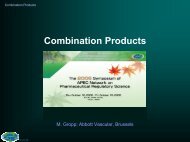4.05 Microbiological Examination of Non-sterile Products
4.05 Microbiological Examination of Non-sterile Products
4.05 Microbiological Examination of Non-sterile Products
- No tags were found...
You also want an ePaper? Increase the reach of your titles
YUMPU automatically turns print PDFs into web optimized ePapers that Google loves.
factor <strong>of</strong> the prepared sample must be used for the test. Where this is not possible due toantimicrobial activity or poor solubility, further appropriate protocols must be developed.If inhibition <strong>of</strong> growth by the sample cannot otherwise be avoided, the aliquot <strong>of</strong> themicrobial suspension may be added after neutralization, dilution or filtration.4-5-3 Neutralization/removal <strong>of</strong> antimicrobial activityThe number <strong>of</strong> micro-organisms recovered from the prepared sample diluted as described in4-5-2 and incubated following the procedure described in 4-5-4, is compared to the number <strong>of</strong>micro-organisms recovered from the control preparation.If growth is inhibited (reduction by a factor greater than 2), then modify the procedure forthe particular enumeration test to ensure the validity <strong>of</strong> the results. Modification <strong>of</strong> theprocedure may include, for example, (1) an increase in the volume <strong>of</strong> the diluent or culturemedium, (2) incorporation <strong>of</strong> a specific or general neutralizing agents into the diluent, (3)membrane filtration or (4) a combination <strong>of</strong> the above measures.Neutralizing agents—Neutralizing agents may be used to neutralize the activity <strong>of</strong>antimicrobial agents (Table <strong>4.05</strong>-I-2). They may be added to the chosen diluent or the mediumpreferably before sterilization. If used, their efficacy and their absence <strong>of</strong> toxicity formicro-organisms must be demonstrated by carrying out a blank with neutralizer and withoutproduct.If no suitable neutralizing method can be found, it can be assumed that the failure to isolatethe inoculated organism is attributable to the microbicidal activity <strong>of</strong> the product. Thisinformation serves to indicate that the article is not likely to be contaminated with the givenspecies <strong>of</strong> the micro-organism. However, it is possible that the product only inhibits some <strong>of</strong>the micro-organisms specified herein, but does not inhibit others not included amongst thetest strains or for which the latter are not representative. Then, perform the test with thehighest dilution factor compatible with microbial growth and the specific acceptance criterion.4-5-4 Recovery <strong>of</strong> micro-organism in the presence <strong>of</strong> productFor each <strong>of</strong> the micro-organisms listed in Table <strong>4.05</strong>-I-1, separate tests are performed. Onlymicro-organisms <strong>of</strong> the added test strain are counted.4-5-4-1 Membrane filtrationUse membrane filters having a nominal pore size not greater than 0.45 mm. The type <strong>of</strong>filter material is chosen in such a way that the bacteria-retaining efficiency is not affected bythe components <strong>of</strong> the sample to be investigated. For each <strong>of</strong> the micro-organisms listed inTable <strong>4.05</strong>-I-1, one membrane filter is used.4/29



